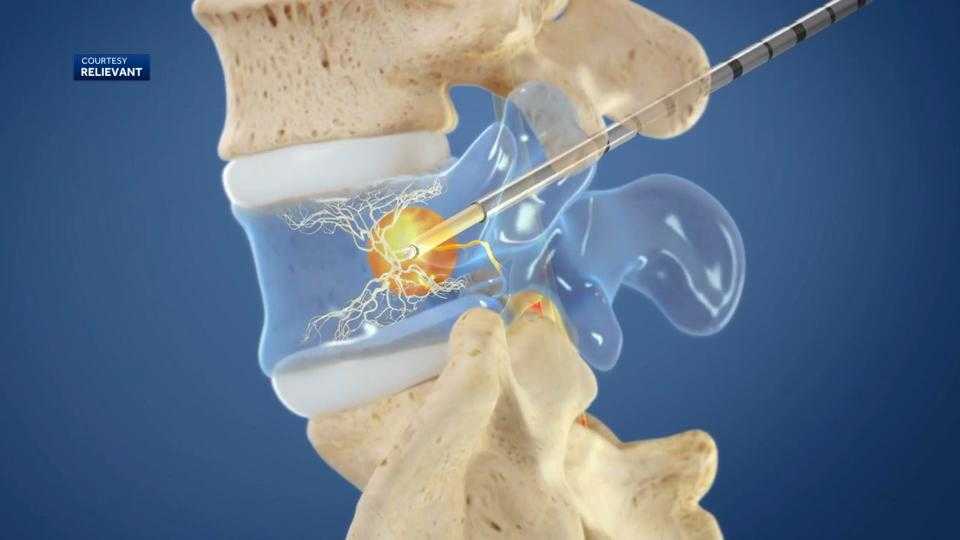New, minimally invasive procedure in Baltimore treats back pain

A new procedure to treat back pain is available in Maryland. It has a high success rate and doesn’t involve major surgery.Eight out of 10 Americans have back pain, which has become the leading cause of disability worldwide.Jimmie Wiggins is one of Dr. Thomas Lee’s Intracept procedure success stories. Watching him walk down the hall, one would never know Wiggins suffered from debilitating back pain for 23 years.”It’s been really bad, really bad. (It) stopped me from doing a lot of stuff,” he said. “It’s good to be pain-free … walking, running, jogging, exercising. I went back to what I used to do years ago.”Intracept is a minimally invasive, outpatient procedure in which a surgeon inserts an instrument into the vertebrae and ablates, or burns, the nerves within the spine, turning off the pain signal to the brain. Lee likens it to blocking numbers on a cellphone.”You have spam calls or unwanted calls; you try to block those calls from coming. So, basically, you’re blocking those calls from coming in. The cellphone is still working and intact, but you’re shutting that signal off. So, in other words, you’re trying to shut off the pain signal,” said Lee, a doctor at the Sinai Rehabilitation Center.Patients like Wiggins can see improvement in two to four weeks. Lee said studies show five years after undergoing the Intracept procedure, one-third of patients are pain-free and almost half have more than 75% relief.But Lee said there is strict criteria for who is eligible for Intracept. He is very selective about who he treats with Intracept.”The patient you’re talking about is patients that have chronic low back pain for at least six months, failed other treatments for at least six months and have the modic changes that are noted in the MRI,” Lee said.An MRI of Wiggins’ spine showed white marks that represent modic changes.”Those are indications that there is inflammation, nerve irritation, swelling that can cause pain,” Lee said.Wiggins said that as of Monday, he is now 100% pain-free and can finally walk his dog, Chance.”(You can) go back to what you used to do, cutting grass, raking leaves. I just do it all now. So, what can I say?” Wiggins said. “I’m living pain-free.”So far, Lee has completed the procedure on 10 patients and said he is happy with all of their results.Watch the video above for the full story.
A new procedure to treat back pain is available in Maryland. It has a high success rate and doesn’t involve major surgery.
Eight out of 10 Americans have back pain, which has become the leading cause of disability worldwide.
Jimmie Wiggins is one of Dr. Thomas Lee’s Intracept procedure success stories. Watching him walk down the hall, one would never know Wiggins suffered from debilitating back pain for 23 years.
“It’s been really bad, really bad. (It) stopped me from doing a lot of stuff,” he said. “It’s good to be pain-free … walking, running, jogging, exercising. I went back to what I used to do years ago.”
Intracept is a minimally invasive, outpatient procedure in which a surgeon inserts an instrument into the vertebrae and ablates, or burns, the nerves within the spine, turning off the pain signal to the brain. Lee likens it to blocking numbers on a cellphone.
“You have spam calls or unwanted calls; you try to block those calls from coming. So, basically, you’re blocking those calls from coming in. The cellphone is still working and intact, but you’re shutting that signal off. So, in other words, you’re trying to shut off the pain signal,” said Lee, a doctor at the Sinai Rehabilitation Center.
Patients like Wiggins can see improvement in two to four weeks. Lee said studies show five years after undergoing the Intracept procedure, one-third of patients are pain-free and almost half have more than 75% relief.
But Lee said there is strict criteria for who is eligible for Intracept. He is very selective about who he treats with Intracept.
“The patient you’re talking about is patients that have chronic low back pain for at least six months, failed other treatments for at least six months and have the modic changes that are noted in the MRI,” Lee said.
An MRI of Wiggins’ spine showed white marks that represent modic changes.
“Those are indications that there is inflammation, nerve irritation, swelling that can cause pain,” Lee said.
Wiggins said that as of Monday, he is now 100% pain-free and can finally walk his dog, Chance.
“(You can) go back to what you used to do, cutting grass, raking leaves. I just do it all now. So, what can I say?” Wiggins said. “I’m living pain-free.”
So far, Lee has completed the procedure on 10 patients and said he is happy with all of their results.
Watch the video above for the full story.




